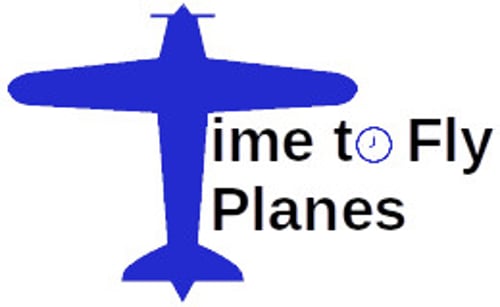Lower Cost Per Hour©
Gary Palmer Nov 8 2021
Simply put, depending how you choose to acquire hours, your costs can vary greatly! For example, to acquire 1000 hours as a renter you can expect to pay around $170,000. If you own the plane that $170,000 drops to $116,000. If you are in a partnership it can drop further to a crazy $80,000. Yes, that is more than $90,000 savings. Below describes the basis for these numbers.
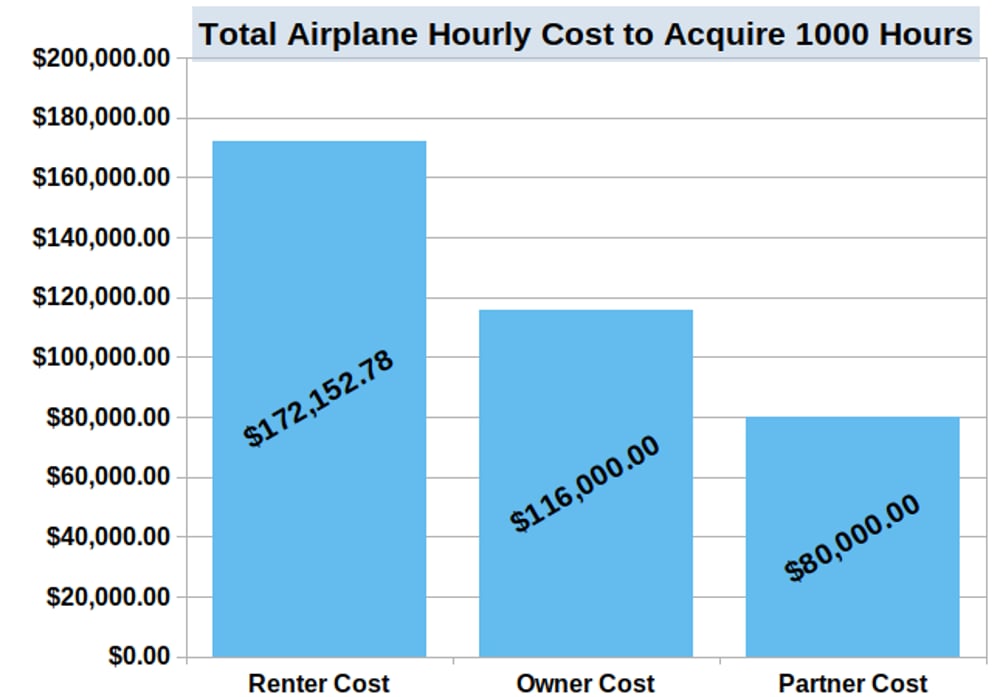
These costs need several assumption: fuel, average rental rates (based on the Los Angeles area), fuel burn, oil and oil change costs, regular maintenance (like wheels, brakes, oil added between changes), insurance, monthly fees (like tie down), and of course, some set aside for engine overhaul. We also add a trivial amount for “extras”.
Rental Costs
A survey of eight flight schools (two in the Los Angeles area) identified an average rental cost of just under $170/hour. This survey included a couple light sport aircraft and a Cirrus. These are wet (fuel included) rentals. Renters are advised to carry rental insurance which was estimated at a cost of $500/year. For 180 hours/year (an aggressive but reasonable number) the hourly cost is about $172. When renting you pay per Hobbs hour which is typically 15-20% higher than a Tach hour, owners and partners pay by Tach hour. Yellow boxes are equation parameters.
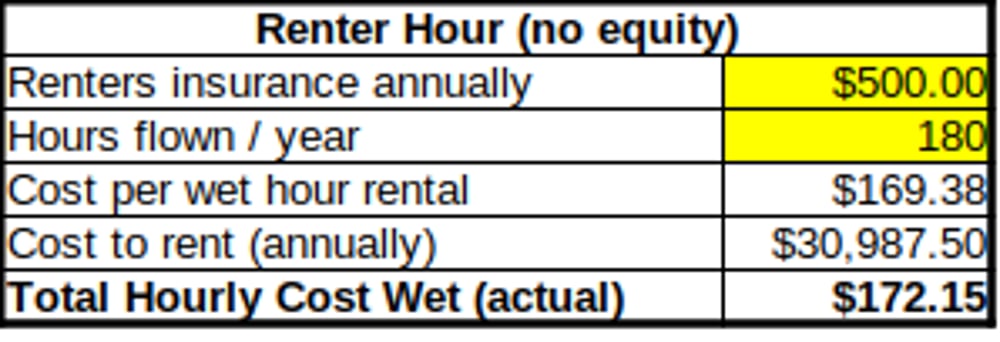
Ownership Costs
Owning a plane can bring the most flexibility and freedom, but when considering the acquisition of hours at optimal costs, it may not be the best choice. Owning your own plane guarantees that when you want to fly, there is a plane available, you know the condition and status right to about how much fuel is in the tanks. Unfortunately, the option comes with a price. You have to plan for annual inspections, cost to tie down or hanger, maintenance, oil changes, wear item replacements (like brakes), GPS database updates, insurance, and more as noted in the following table of costs. A Cessna 172 actual costs was used for this example. Yellow boxes are numbers which drive the calculations shown in the white boxes.
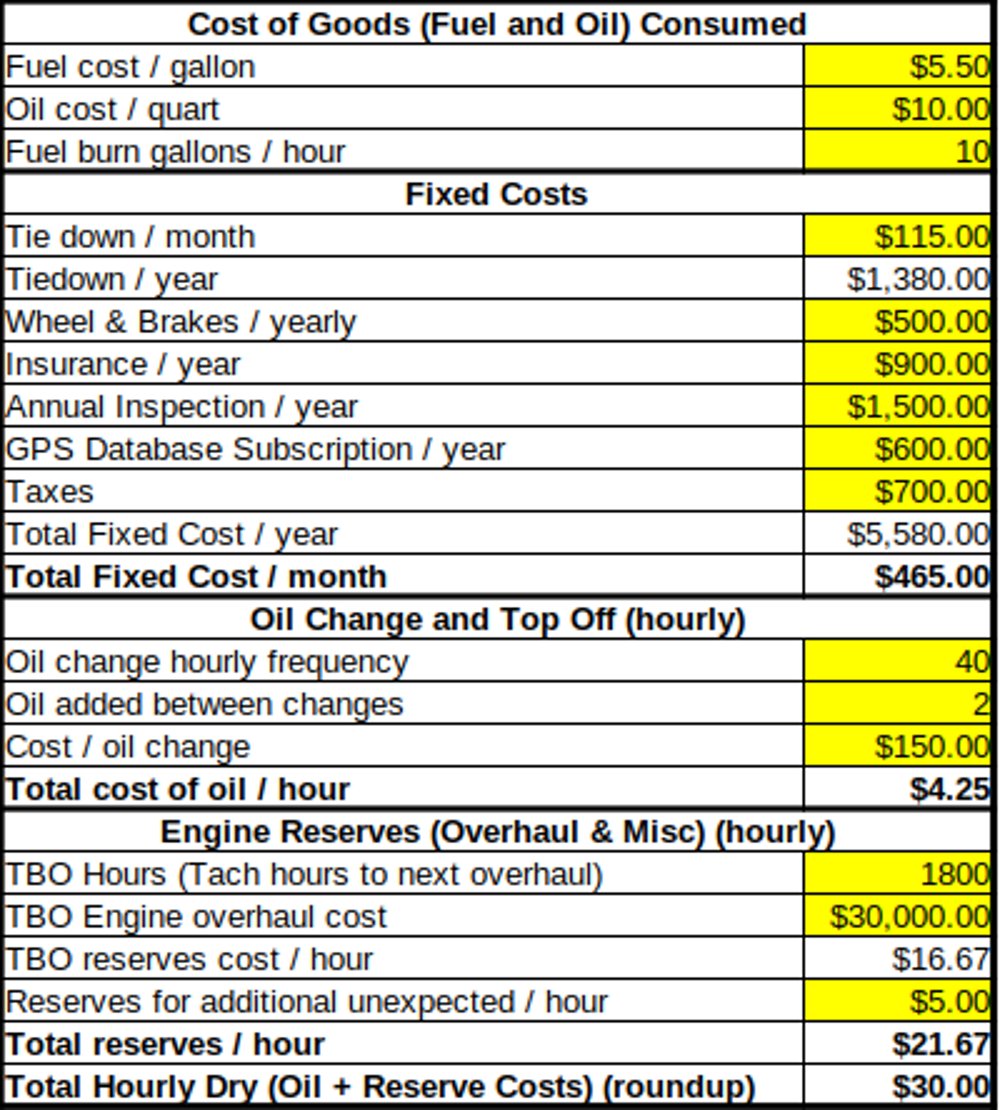
The final numbers here are about $465/month to have the plane on the ground and about $30/hour to fly the plane, but this is NOT including the cost of fuel per hour flown nor the cost to purchase the plane which could range anywhere from $75,000 used to over $400,000 new. So it is not yet a fair comparison to renting a plane.
To compare to a rental we need to add a few things together. Reference the owner cost table below, the Cost of hours / month dry is simply the total hourly ($30/hour) times the number of hours flown/month. Cost of fuel / month is the number of gallons fuel consumed / month times the cost/gallon. Adding the fixed monthly to those two and divide by the hours / month and the owners cost / hour wet is about $116/hour to fly. Remember that the owner pays by tach not Hobbs hour saving an additional 15-25 percent of the hourly cost!
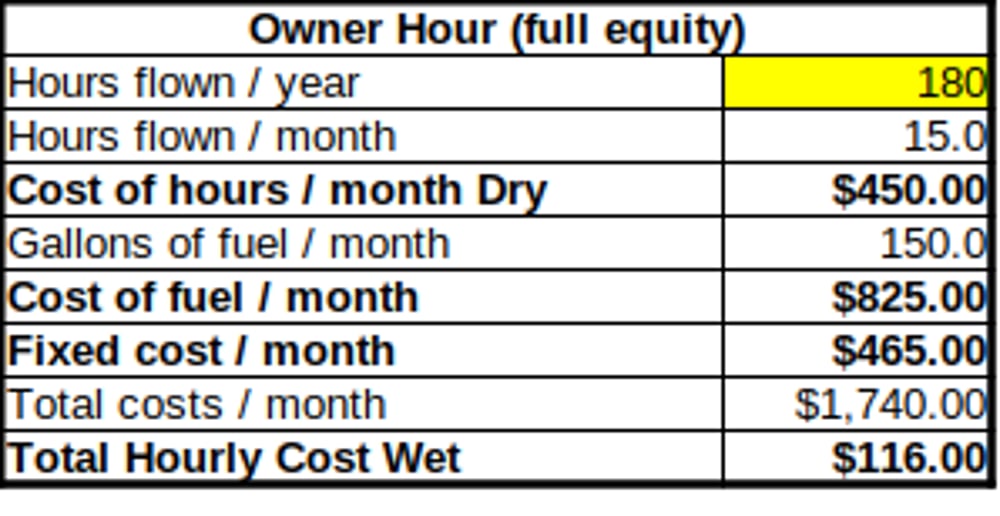
Partnership Costs
The partnership is almost like owning but the costs are split between the members who form the partnership. There are many types and sizes of partnerships. For a time builder having a large number of partners (say 8 or more) can limit availability of the airplane. Have too small a partnership (say one other person) and the costs go up. For this example we are using a partnership size of four as that lends itself to the idea of four weeks in a month which can guarantee access for a week of the month. Of course, when the plane is not is use, there can be greater flexibility.
The starting costs are about the same as for an owned airplane but the cost per partner drops. The monthly fixed cost is only $120/partner as opposed to $465/month for the owner. The oil and engine reserves which generally contribute to the hourly engine wear and maintenance costs are $30/hour.
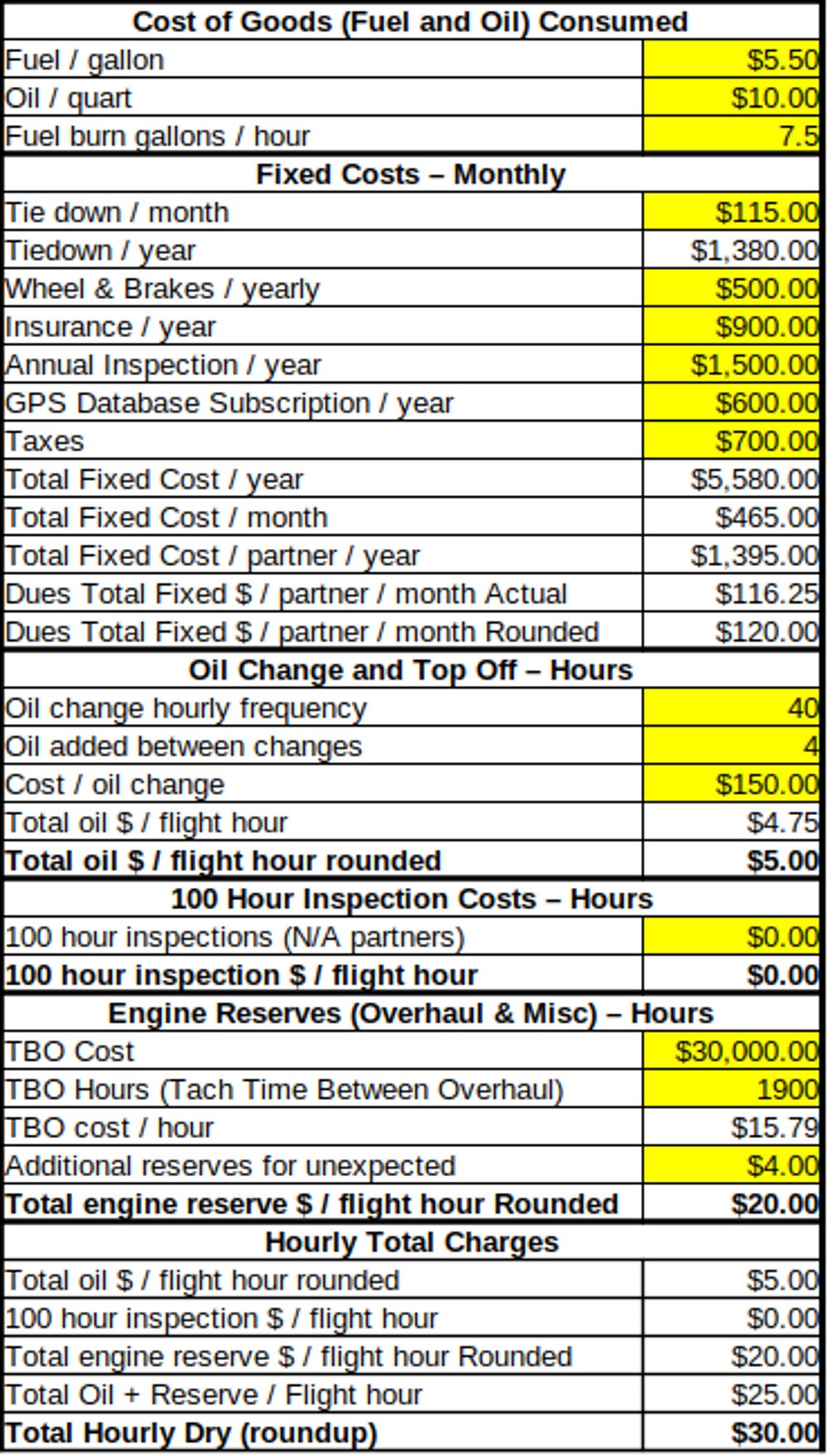
Now we can look at the hourly operating cost for a partner. Just like the owner example, we have the partner fly 180 hours a year. The “wrap rate” of $80/hour is the sum of the fixed costs plus the reserves plus gas and oil. For the partner this is $80/hour compared to the owner $116 and the renter $172. This has the partner saving over $90/hour! Remember that the partner pays by tach not Hobbs hour saving an additional 15-25 percent of the hourly cost!
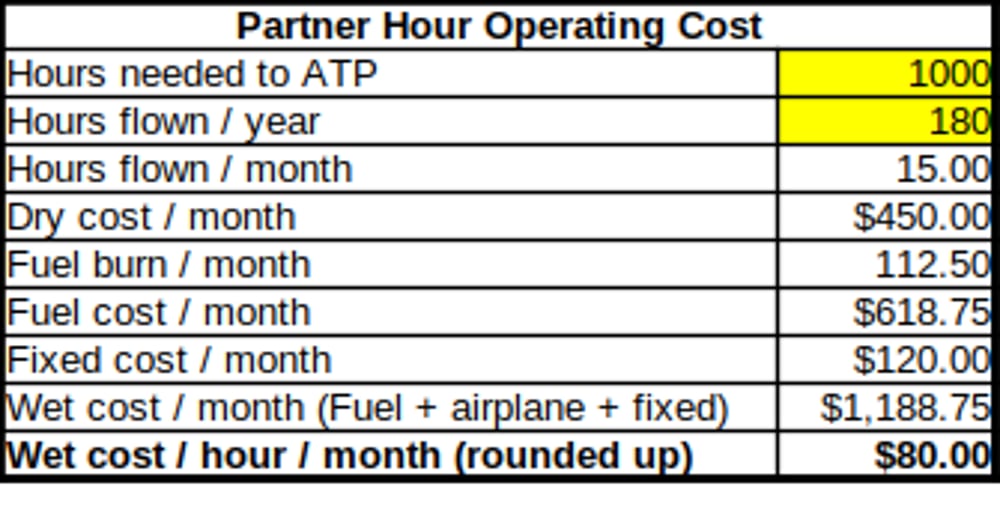
Reducing Costs
It is obvious that owners and partners have fixed as well hourly operating costs. The fixed cost get spread over the hours flown, so the more hours flown the lower the fixed cost component for each hour. Fuel costs can be a factor since they are variable. The dramatic cost reduction achieved by flying minimal monthly hours can be seen in the following graphic. The line at 120 is the fixed monthly cost, the other two are the wet and dry hourly cost including the fixed monthly. As you see, savings start after the third hour and the cost per hour continues to reduce with each hour flown after.
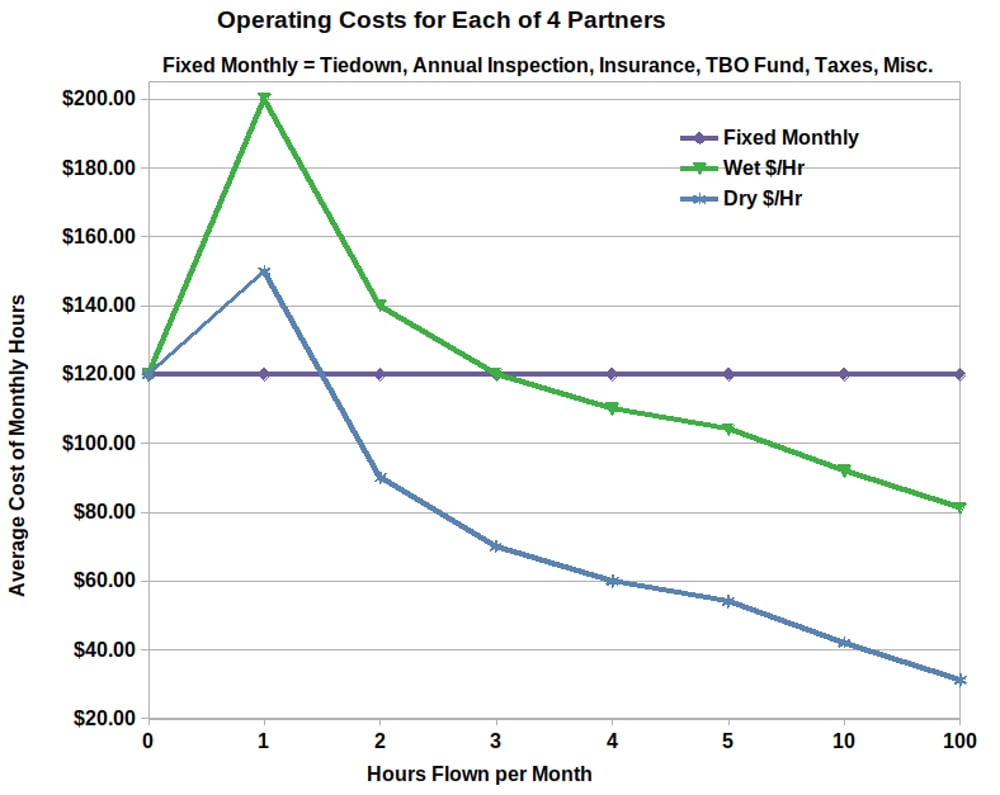
Summary
That was a lot of math, but we wanted to provide the facts used to justify the claims. The partnership numbers are drawn from a Piper PA28-140 which was acquired for the purposes of a partnership. We specifically did not address acquisition costs because of the variability. Partnerships tend to cost a bit more to join than just the value of the plane split among the partners. There are several reasons and the first is the operating and creation costs. But that is absorbed in the investment. Owners and partners have the option of selling what they own, renters have no equity. One way to consider these options is that owning is like buying a house. Renting is the same, you pay for the time you live there and have nothing when done. Partnership is like buying a smaller apartment in a building with partners. You have something to own but could not have acquired the whole building without a larger outlay.
Owners have the greatest flexibility for access. Renters are subject to the availability at the school or FBO with always a specter of being preempted for a check ride or damage to the airplane by another student. Partners are a balance between owning and renting which is more approachable financially with more dependable access than a school or FBO. A copy of the spreadsheets shown in this presentation can be provided if you send a request to us at TimeToFlyPlanes.
Isn’t it your time to fly and build those hours?
